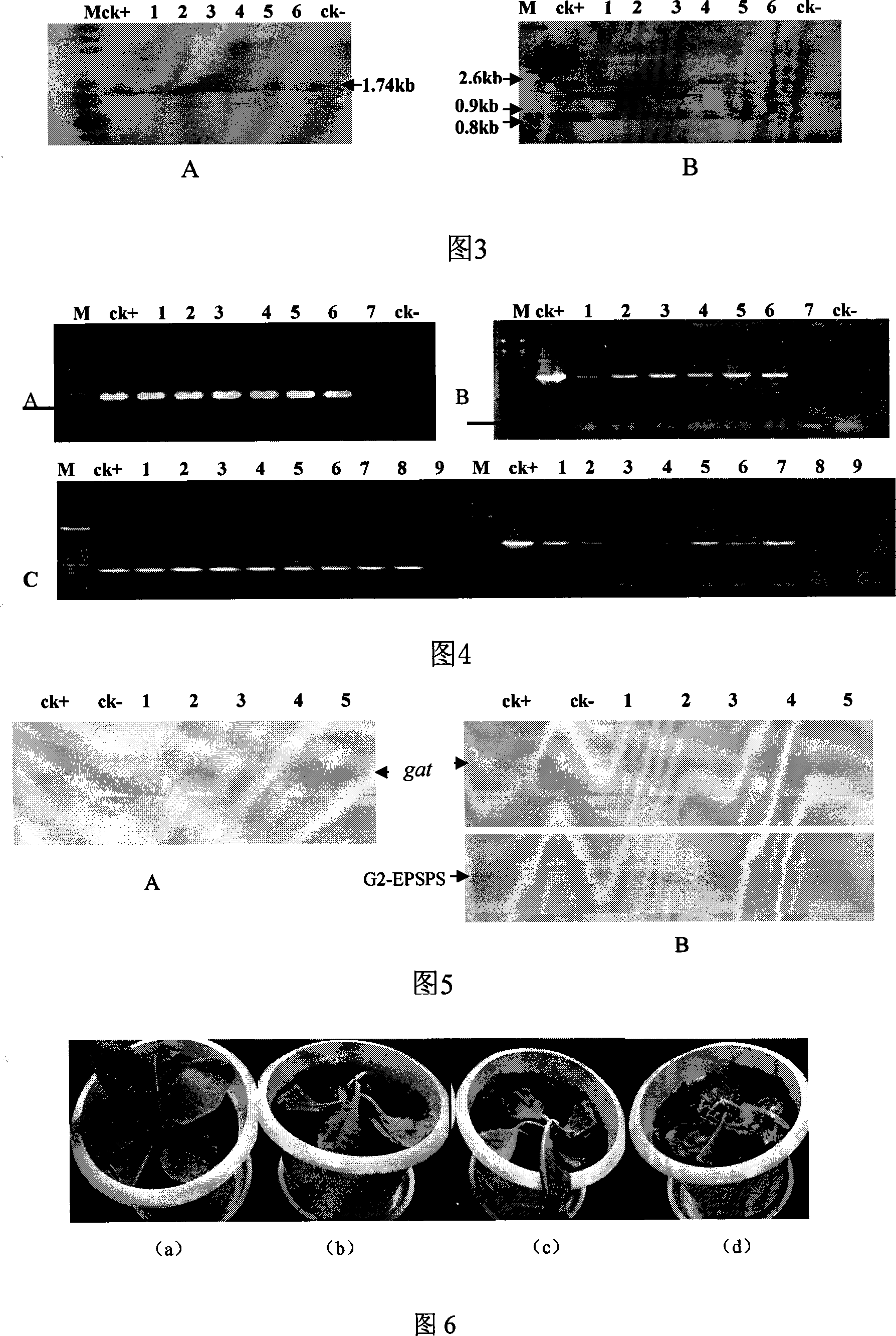Bivalent expression carrier for culturing anti-glyphosate plants
An expression vector, glyphosate technology, applied in the direction of plant genetic improvement, botany equipment and methods, use of vectors to introduce foreign genetic material, etc., can solve the problem of lower crop yield, unsatisfactory glyphosate resistance effect, impact on Problems such as plant reproduction and development, to improve the ability to resist glyphosate and avoid negative effects
- Summary
- Abstract
- Description
- Claims
- Application Information
AI Technical Summary
Problems solved by technology
Method used
Image
Examples
Embodiment 1
[0053] The construction of embodiment 1 bivalent plant expression vector
[0054] 1) Using pGAT plasmid as template, with 5'G CTCGAG ATGATTGACGTGAACCCAAT 3' and 5'G GTTAAC TTATGCGATCCTCTTGTACA 3' is a primer (adding XhoI and hpaI sites) to amplify by PCR to obtain gene fragments with XhoI and hpaI restriction sites at both ends, and connect to the T-vector;
[0055] 2) The ligation product in 1) was transformed into Escherichia coli DH5α, and a positive clone was selected and named as pGAT-T;
[0056] 3) The p4A and pSK plasmids were digested by KpnI and HindIII, and the 1.4kb and 2.7kb DNA bands were recovered respectively. After ligation, they were transformed into E. coli DH5α, and the positive clones were selected and named pSK4A;
[0057] 4) The pSK4A and pGAT-T plasmids were digested by XhoI and hpaI, and the DNA bands of 4.1kb and 435bp were recovered respectively, and after ligation, they were transformed into E. coli DH5α, and positive clones were selected and name...
Embodiment 2
[0065] Example 2 Agrobacterium-mediated method to obtain bivalent transgenic tobacco
[0066] In this example, the transgenic tobacco with G2-aroA gene and gat gene was successfully obtained by using the Agrobacterium-mediated method.
[0067] The tobacco receptor material used is NC89, and the Agrobacterium is LBA4404. The specific operation steps are as follows:
[0068] 1) Preparation of competent Agrobacterium tumefaciens LBA4404
[0069] (1) Pick a single colony from the plate, inoculate it into 5ml YEB liquid medium (containing streptomycin Strep 125mg / L), and cultivate overnight at 28°C and 250rpm with shaking
[0070] (2) Take 2ml of bacterial liquid, add it to 50ml of YEB liquid medium (containing Strep125mg / L), shake and culture at 28°C and 250rpm until OD 600 About 0.6 or so
[0071] (3) Transfer the bacterial solution to a 50ml sterile centrifuge tube and place in an ice bath for 30min. Centrifuge at 5000rpm for 5min
[0072] (4) Discard the supernatant and us...
experiment example 1
[0086] Experimental Example 1 Molecular Detection of Transgenic Tobacco
[0087] 1.1 Extraction of tobacco DNA
[0088] 1) 25-50mg of fresh tobacco leaves are ground in a 1.5ml Eppendorf tube
[0089] 2) Add 700 μl 65°C preheated DNA extraction buffer (2% (W / V) CTAB, 1.42M NaCl, 20mM EDTA, 100mM Tris-HCl, 2% mercaptoethanol, pH8.0)
[0090] 3) Add 7μl RAase (20mg / ml), bathe in water at 65℃ for 1h
[0091] 4) Centrifuge at room temperature for 10 minutes
[0092] 5) Take the supernatant, add an equal volume of chloroform-isoamyl alcohol for extraction
[0093] 6) Centrifuge at room temperature for 10 minutes
[0094] 7) Take the supernatant, add 2 times the volume of absolute ethanol and 1 / 10 volume of 3M NaAc (pH5.2), and precipitate at -20°C for 30 minutes
[0095] 8) Centrifuge at 12000rpm, 4°C for 10min
[0096] 9) The precipitate was rinsed once with 70% ethanol, centrifuged and dried
[0097] 10) Add appropriate amount of TE to dissolve
[0098] 11) Measure the co...
PUM
 Login to View More
Login to View More Abstract
Description
Claims
Application Information
 Login to View More
Login to View More - R&D
- Intellectual Property
- Life Sciences
- Materials
- Tech Scout
- Unparalleled Data Quality
- Higher Quality Content
- 60% Fewer Hallucinations
Browse by: Latest US Patents, China's latest patents, Technical Efficacy Thesaurus, Application Domain, Technology Topic, Popular Technical Reports.
© 2025 PatSnap. All rights reserved.Legal|Privacy policy|Modern Slavery Act Transparency Statement|Sitemap|About US| Contact US: help@patsnap.com


